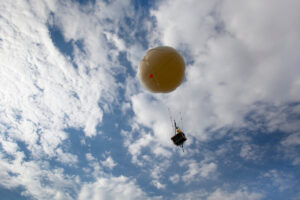Staying Safe in the Summer Skies
Summertime is the season of fun and adventure, but for pilots it’s also a time of increased risk and responsibility. Preflight preparation is essential to prevent costly mistakes and accidents, especially when temperatures rise during the hotter months of the year. Pilots should be aware that flying can be more challenging during the summer months due to rising temperatures.
We’ve compiled a list of a few suggestions to help pilots keep your cool in the hot summer months. With these helpful suggestions, you’ll be ready to fly through your next summer mission without a hitch.
Pre-Checks
Checking the weather is one of the most important steps in a pilot’s preflight preparations. Before taking off, make sure you take some time to check your local weather forecast and any available information on the flight path. Pay attention to wind speed and direction, as well as temperature and air pressure. Be aware of any thunderstorms or heat advisories in the area. If you notice any potential hazards, make sure to plan an alternate route or delay the flight until conditions are more favorable.
Another check before is making thoroughly inspecting the aircraft and all its systems. Check the fuel tanks are topped off, that the engine is running correctly, and that all instruments are functioning properly. Additionally, be sure to review the flight plan with your crew to ensure everyone is on the same page regarding their responsibilities during the flight. With these pre-flight procedures, you’ll be well on your way to a successful and safe summer flight.
Awareness of Turbulence and Thunderstorms During Flight
It is important to be aware of potential turbulence and thunderstorms in the area. The effects of these weather conditions can vary depending on what type of aircraft is being flown. For instance, small aircraft may suffer from reduced lift due to turbulence or significant reductions in speed and altitude due to thunderstorm activity It is best to avoid these conditions, if possible, as they can cause unexpected shifts in air pressure and wind direction that can make flying difficult.
Thunderstorms
Be on the lookout for any signs of thunderstorm activity such as dark cumulonimbus clouds, strong winds or downdrafts, heavy rain or hail, and lightning flashes. If any of these are present, consider taking evasive action to avoid getting caught up in a powerful thunderstorm system. This can include changing altitude quickly or turning around and flying away from the source of danger if possible. It is recommended to avoid thunderstorms and convective activity by at least 20 miles.
If avoidance is not an option, prepare the aircraft for turbulence as you will likely experience significant amounts while navigating through storms. To minimize its effects, reduce speed and acceleration forces by decreasing the bank angle and descent rate accordingly. Furthermore, due caution should be taken near storm cells due to potential wind shear conditions which could cause rapid shifts in airspeed.
Flying in Windy Conditions
Windy conditions can present an additional challenge when flying during the summer months. Before taking off, be sure to check current wind speed and direction so that you can plan your route accordingly. Additionally, if you encounter strong winds while in the air, consider changing altitude slightly to avoid any dangerous crosswinds. By staying aware of your aircraft’s position relative to the wind direction, you’ll be able to remain on track throughout your mission.
Flying in windy conditions during the summer months can be a dangerous and unpredictable experience. Turbulence, wind shear, and microburst events are all weather events associated with windy conditions that could significantly affect flight performance and safety.
- Turbulence is caused by changes in airflow over a plane, resulting in bumpy rides for passengers and crew.
- Wind shear occurs when there is an abrupt change in the wind speed or direction along the flight path which can cause a plane to suddenly ascend or descend if not managed correctly.
- Lastly, microbursts can move down from clouds and cause aircraft to stall due to sudden directional shifts as well as increased drag forces acting on the aircraft.
Flying in Extreme Heat
When flying in areas of extreme temperature during the summer season, it is important to adjust your altitude accordingly. This is because extreme temperatures can impact the performance and handling of an aircraft by making it more difficult for onboard systems and components to function properly. For example, the air density at higher altitudes decreases as temperature increases, resulting in reduced lift, increased drag, and a decrease in engine power. This can lead to decreased fuel efficiency and longer flight times if not managed carefully.
Generally speaking, when temperatures rise above 70°F (21°C), pilots should consider lowering their altitude below 5,000 feet (1,524 meters). Check for any other weather hazards that may arise such as turbulence or strong airflows that could interfere with safe flight operation. Additionally, be aware of any airspace restrictions in order to ensure compliance with local aviation regulations.
What Can You Do for Yourself?
As we’ve mentioned, there are things you’ll want to think about before and during your flight regarding your aircraft and flight plan. But what can you do for yourself to prepare for the heat?
- Dress for the season: Dress in lightweight, breathable clothing appropriate for the season in order to ensure comfort and safety while on flight. Your company may have separate uniform requirements for summer months.
- Invest in sunglasses and sunscreen: It’s important to have proper eye protection from the sun’s glare as well as wearing sunscreen to protect their skin from harmful UV rays while flying in hot temperatures.
- Stay hydrated: To remain alert and focused, it is important to stay hydrated throughout your flight by bringing plenty of water or juices with you while onboard the aircraft.
Last, But Not Least
Communication between crew members and air traffic control is essential for pilots to receive accurate updates regarding weather patterns which may interfere with safe flight operation so you can effectively respond without compromising safety.
By following these tips for flying in the summertime, you will be well on your way to a safe and successful mission! Always take extra time for pre-flight preparation and make sure to stay up to date on local weather forecasts before taking off. Remain alert and aware of any potential turbulence, thunderstorms, or windy conditions that may affect your flight path. And be physically and personally prepared for a flight in the heat and sun. Have a great summer!










